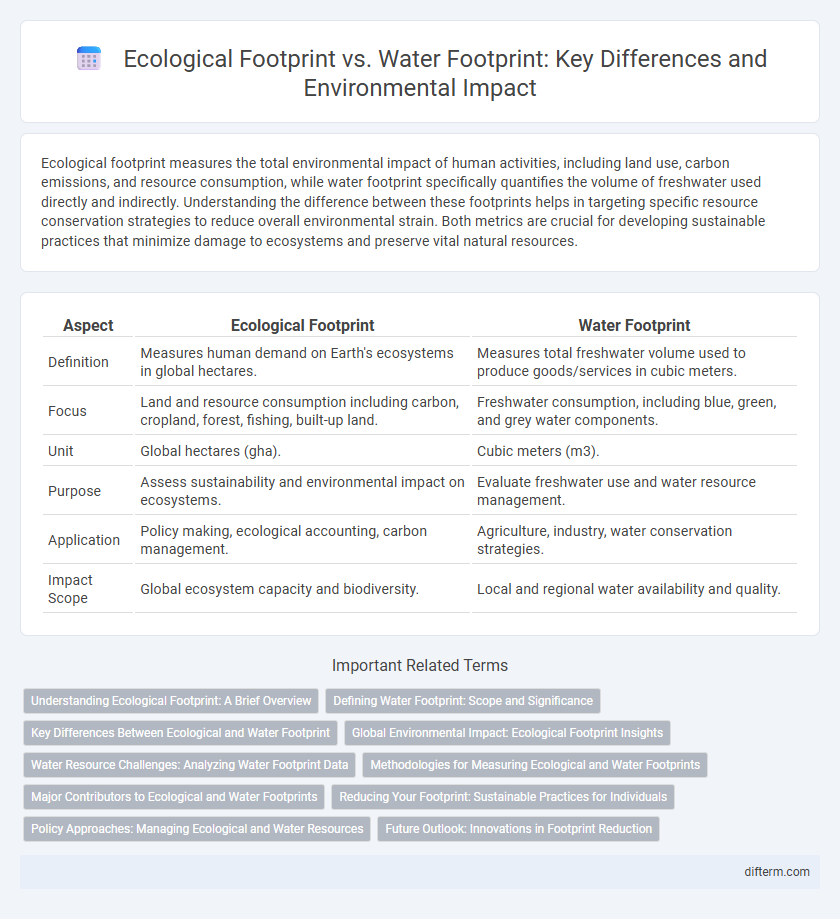Ecological footprint measures the total environmental impact of human activities, including land use, carbon emissions, and resource consumption, while water footprint specifically quantifies the volume of freshwater used directly and indirectly. Understanding the difference between these footprints helps in targeting specific resource conservation strategies to reduce overall environmental strain. Both metrics are crucial for developing sustainable practices that minimize damage to ecosystems and preserve vital natural resources.
Table of Comparison
| Aspect | Ecological Footprint | Water Footprint |
|---|---|---|
| Definition | Measures human demand on Earth's ecosystems in global hectares. | Measures total freshwater volume used to produce goods/services in cubic meters. |
| Focus | Land and resource consumption including carbon, cropland, forest, fishing, built-up land. | Freshwater consumption, including blue, green, and grey water components. |
| Unit | Global hectares (gha). | Cubic meters (m3). |
| Purpose | Assess sustainability and environmental impact on ecosystems. | Evaluate freshwater use and water resource management. |
| Application | Policy making, ecological accounting, carbon management. | Agriculture, industry, water conservation strategies. |
| Impact Scope | Global ecosystem capacity and biodiversity. | Local and regional water availability and quality. |
Understanding Ecological Footprint: A Brief Overview
Ecological footprint measures the land and resources needed to sustain a population's consumption and waste generation, encompassing carbon emissions, cropland, grazing, fishing, and forest use. Unlike water footprint, which quantifies freshwater consumption and pollution in liters, ecological footprint offers a broader view of human environmental impact by translating resource use into global hectares. Understanding ecological footprint enables policymakers and individuals to gauge sustainability and make informed decisions to reduce pressure on ecosystems.
Defining Water Footprint: Scope and Significance
Water footprint quantifies the total volume of freshwater used directly and indirectly by an individual, organization, or product, encompassing blue, green, and grey water components. It highlights water consumption and pollution throughout supply chains, providing a detailed measure of freshwater resource impact beyond ecological footprint assessments. Understanding water footprint is crucial for sustainable water management and reducing water scarcity risks globally.
Key Differences Between Ecological and Water Footprint
Ecological footprint measures the total demand on Earth's ecosystems, encompassing carbon emissions, land use, and resource consumption, while water footprint specifically quantifies freshwater usage across production and consumption activities. The ecological footprint provides a broad assessment of environmental impact on global biocapacity, whereas the water footprint offers detailed insights into water consumption and pollution within regions or industries. Understanding the distinction is crucial for targeted sustainability strategies addressing both land-based and water resource challenges.
Global Environmental Impact: Ecological Footprint Insights
The ecological footprint quantifies the total biologically productive land and water area required to sustain human activities, encompassing carbon emissions, cropland, and forest use, while the water footprint specifically measures freshwater consumption for products and processes. Globally, the ecological footprint reveals that humanity is using resources at about 1.7 times the Earth's capacity, highlighting significant overshoot and unsustainable demand on environmental systems. Insights from ecological footprint data drive policies for reducing carbon emissions, conserving biodiversity, and promoting sustainable land and water management to mitigate global environmental impact.
Water Resource Challenges: Analyzing Water Footprint Data
Water footprint analysis reveals critical insights into freshwater consumption and pollution linked to human activities, highlighting regions facing acute water scarcity and stress. Understanding blue, green, and grey water components enables targeted strategies for sustainable water resource management and pollution reduction. Comparative evaluation with ecological footprints emphasizes water footprint's role in addressing water resource challenges and ensuring long-term ecosystem resilience.
Methodologies for Measuring Ecological and Water Footprints
Methodologies for measuring ecological footprints involve analyzing land use, energy consumption, and resource demand to estimate the biologically productive area required to sustain a population. Water footprint assessment quantifies freshwater use by differentiating between blue (surface and groundwater), green (rainwater), and grey (polluted) water components to provide a comprehensive measure of water consumption and pollution. Both methodologies utilize life cycle assessment (LCA) techniques and spatial data analysis to improve accuracy and facilitate sustainable resource management.
Major Contributors to Ecological and Water Footprints
Major contributors to the ecological footprint include carbon emissions from fossil fuel consumption, deforestation for agriculture and urban development, and overuse of natural resources like minerals and biomass. The water footprint is largely driven by agricultural irrigation, industrial water use, and domestic consumption patterns. Both footprints are significantly impacted by meat production, energy consumption, and inefficient water management practices.
Reducing Your Footprint: Sustainable Practices for Individuals
Reducing your ecological and water footprints involves adopting sustainable practices such as minimizing energy consumption, choosing plant-based diets, and conserving water through efficient fixtures and mindful usage. Implementing rainwater harvesting and supporting products with low water and carbon footprints can significantly lessen environmental impact. Personal lifestyle changes that prioritize resource conservation contribute to a healthier planet and promote long-term sustainability.
Policy Approaches: Managing Ecological and Water Resources
Effective policy approaches for managing ecological and water resources prioritize integrated resource management frameworks that address both ecological footprints and water footprints simultaneously. Regulatory measures such as water usage permits and land-use zoning promote sustainable consumption patterns while reducing environmental degradation. Implementing these policies enhances resource efficiency, mitigates habitat loss, and supports long-term ecosystem resilience.
Future Outlook: Innovations in Footprint Reduction
Emerging technologies in ecological footprint reduction focus on renewable energy adoption, sustainable agriculture, and waste minimization to curb environmental impact. In water footprint management, innovations include advanced water recycling, efficient irrigation systems, and real-time monitoring of water use in industries. These strategies collectively aim to enhance resource efficiency and support long-term ecological balance.
Ecological footprint vs Water footprint Infographic

 difterm.com
difterm.com